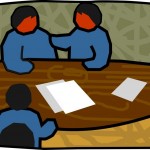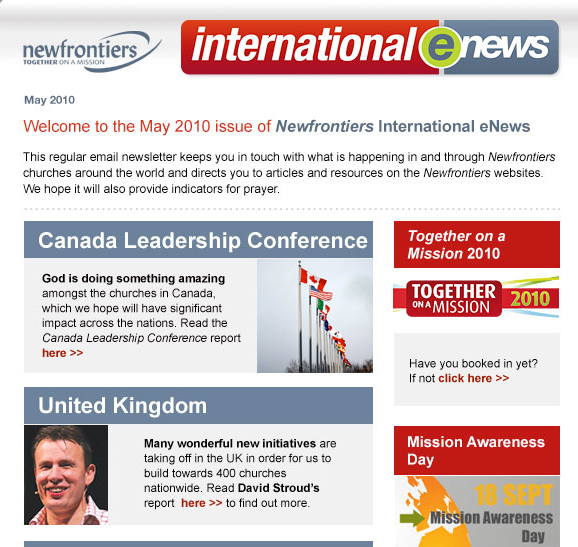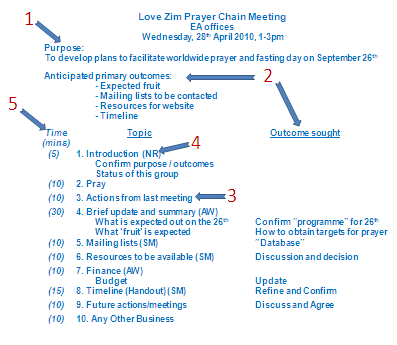
International eNews
Before continuing this series on Effective Meetings, and looking at Agendas, I want to commend the International eNews of Newfrontiers. Through this you can receive a monthly update of news around the world (see extract from the current one below) and have food for prayer for yourself or the church. To subscribe Click here>>

Agendas
To many people an agenda is just a list of topics you plan to discuss in a meeting. But it can provide so much more if you give it a little fore-thought. This can really serve you and save you a great deal of time. A well constructed agenda can also make a meeting much more fulfilling as it ensures everyone knows where you are going and it guides you to the essence of what needs to be addressed without a lot of general discussion.
There are various elements which may be on a good agenda. The numbers here relate to those in red in the sample agenda below:
1. Purpose of meeting
2. Outcomes expected – both general and specifically related to individual items
3. Handling actions from the last meeting if needed to further a particular topic
4. Who is expected to come prepared to introduce and/or lead a discussion
5. Timing (which relates to chairing – a topic I shall address separately)
Recently I was asked to plan and chair a meeting related to a Global Day of Prayer for Zimbabwe, organised by an informal group of interested people under the title of LoveZim. This Day will take place on September 26th 2010. I have modified the agenda for that meeting as an example to help highlight each of the points we have been considering.
 This has been laid out using the ‘tables’ feature in Windows, with the grid ‘hidden’. This gives a tidy presentation with the ability to move complete lines when planning the agenda without losing the format.
This has been laid out using the ‘tables’ feature in Windows, with the grid ‘hidden’. This gives a tidy presentation with the ability to move complete lines when planning the agenda without losing the format.
Purpose and Outcomes
All participants knew the general purpose of the meeting but for various reasons we had not been able to pre-circulate the agenda. But I did have direct contact with those who needed to come prepared. Accordingly I summarised the purpose of the meeting and the expected outcomes at the start. This was also clearly laid out on the agenda so only a brief summary was needed and no-one would have been ‘caught out’ if asked to say something.
The meeting had various components but we needed to end up with a clear list of decisions and actions, with the relevant people knowing what action was expected and by when it should be taken. Each item on the agenda was annotated with the purpose for its inclusion.
Prayer
We always need God’s help! It is easy to feel there is so much on an agenda that we do not have time to pray. The other way of looking at that is that there is so much on the agenda that we cannot afford not to pray! So, after introducing the purpose and outcomes we prayed together. This gave not only a sense of peace and togetherness but also gave the opportunity for God to speak to us prophetically if He wanted to.
Minutes and Actions
Early items on an agenda are usually to confirm everyone’s agreement that the minutes of the previous meeting were accurate and that the agreed actions have been taken. By circulating these in advance this is a quick process and time can be focussed on only those actions that need further discussion. On this occasion there were no previous minutes to consider.
Who?
The initials of the person expected to introduce the topic were placed alongside the relevant agenda item.
How long?
It is easy for people to talk for too long about their particular area of interest so, in chairing the meeting, I had decided in advance how long I was devoting to each topic. Clearly, this must include flexibility but it allows the whole agenda to be given appropriate time without the feeling of pressure on the later items. I do not normally include these on the full agenda but write it on my own copy.
Chairing meetings
In the next blog I shall say a little more about chairing meetings before considering minute-taking.
